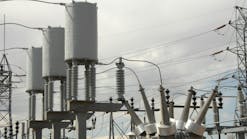Elia owns the transmission system in Belgium as well as 94% (ownership and user rights) of the high-voltage distribution network. The 150-kV to 380-kV transmission system is a key link between the electricity markets in northern and southern Europe. Elia first installed high-temperature, low-sag (HTLS) overhead line aluminum conductor composite core (ACCC) conductors in 2009 and, since then, has completed numerous other projects with HTLS conductors. At that time, the Lisbon 325 ACCC conductors were a relatively new technology, so they were used on a prototype project.
Located in the heart of Europe, the Belgian transmission system is an integral part of the European Network of Transmission System Operators for Electricity (ENSTO-E) interconnected transmission system. As such, it is vital for Elia to increase its energy imports and exports in addition to providing capacity to cope with the planned closure of all nuclear plants by 2025. To meet this challenge, the utility established a working group with the objective to increase the load transfer capacity of some circuits in the existing 380-kV overhead line transmission system from approximately 2000 A to 4000 A.
By the end of 2012, after comparing different scenarios, Elia’s management team approved the use of HTLS conductors on several circuits being upgraded as priority reinforcement of the 380-kV transmission system by 2020-2022. An action plan was defined to mitigate the risks associated with the use of this new technology. Special control measures were taken to ensure the Belgian authorities accepted the technology as safe, and the conductors were subjected to rigorous testing at the qualification phase. The maintenance of satisfactory ground clearances under every system operational situation was an issue of concern for the authorities.
Technical Challenges
Elia needed to increase the load transfer capacity of select circuits under the following constraints:
- Possible reinforcement of the tower foundation system, with limited replacement of angle towers
- On double-circuit lines, the ability to reconductor one circuit with the second circuit in operation
- Need for limited environmental impact.
Compatibility with these three constraints offered the following key advantages:
- Increase in load transfer capacity of each circuit by a factor of two using a conductor of slightly larger diameter with a maximum operating temperature of 150°C (302°F)
- Maximum affordable changes to mechanical loading on the existing supporting towers to limit expenditure and the total cost of reinforcement
- Less time required for restringing the existing circuits with new conductors, resulting in the lowest overall costs compared to other technical solutions.
Project Pre-assessment
During preparation, Elia evaluated all potential technologies, which included visits to the manufacturer’s site as well as meetings with other utilities and the installers of the respective technologies. This project pre-assessment ensured all potential difficulties and risks were evaluated, understood and resolved at an early stage.
Elia established a framework agreement with two conductor manufacturers for the period of 2013 through 2017, with an option to extend it, for the supply of HTLS conductors and the accessories in contact with the conductors, namely a system qualification. Contracts were awarded to two Belgian suppliers — Lamifil, with ACCC core supplied by CTC Cable Corp., and Nexans, with its high-capacity Lo-Sag conductor (ACPR) — to supply the materials for this extensive reinforcement project.
To satisfy the results of Elia’s design studies, specifications for the new conductors had to withstand high-speed winds, thus the need for the conductors to have a low drag coefficient. Belgium has a long tradition of stringing overhead transmission lines with high-quality closed conductors with Z-shaped strands on the external layer to limit the tower loads at high-speed winds, so the existing towers can be maintained. The new conductors were selected to replace existing conductors on the Elia transmission system to minimize the need to reinforce supporting towers and foundations.
Prior to the start of the reinforcement project, Elia arranged an extensive test program for the HTLS conductors and their accessories. Conducted by independent test laboratories, the program included various electrical, mechanical and thermal tests according to international standards as well as Elia’s technical specifications on the HTLS conductor and accessories.
Conductor Installation on Stevin
The current 150-kV grid in the coastal region of Belgium was insufficient to supply all future energy needs. The Stevin project would provide a new 380-kV connection between the coast and the existing 380-kV backbone grid. It addresses four major needs, of which the connection to the growing offshore windfarms in the North Sea and the interconnection capability with the UK are the most important.
Prior to the installation, Elia arranged a one-day course presented by the manufacturers of both HTLS conductor types. The course consisted of a theoretical presentation followed by practical training to demonstrate and practice the making of dead-end clamps and splices.
At the start of the on-site installation, further practical training was given to approximately 40 linemen employed by the overhead line contractors; they each received a personal certification valid for three years. When linemen have gained sufficient experience in handling, stringing and terminating the conductors, only refresher training is deemed necessary. During the conductor stringing of each circuit, representatives from the HTLS conductor manufacturers were present to oversee the installation and assist where necessary.
The design of the dead-end clamps and splices is quite different from the hardware used for conventional conductors, but it ensures installation of the HTLS conductors is relatively easy. The main considerations when installing HTLS conductors is to respect the minimum bending radius and apply adequate back-tension during the conductor stringing operation.
During the stringing process, the contractors used plain metallic sheaves that had to be examined regularly for abrasiveness, debris and marks on the rollers to ensure no surface damage was caused to the soft aluminum outer layers of the HTLS conductor. These metallic sheaves have a larger bending diameter than the wheels usually used. A pulling machine with a trolley diameter of 1800 mm (71 inches) was also specified by one manufacturer.
During installation, the HTLS conductor manufacturers monitored the conductor stringing procedure, checked installation of the accessories and controlled the quality of work. All conductor compressions were subject to a visual inspection by Elia maintenance teams prior to commissioning and immediately after commissioning; the transmission line was also checked with thermo-vision cameras. To secure the knowledge and expertise with respect to HTLS technology, Elia has trained several different crews in its power links maintenance division.
Project Program
To date, Elia has successfully completed the following transmission line reinforcement projects:
- In 2009, a pilot project uprating the 150-kV double-circuit overhead line between Mol and Beringen, 18.8 km (6.04 miles) in length with ACCC Lisbon 325 conductors
- In 2013, uprating the single-circuit interconnection with the Netherlands between Zutendaal and Van Eyck, 30.7 km (19.08 miles) in length with ACCC Antwerp conductors
- In 2015-2016, uprating the 380-kV double-circuit overhead line between Horta and Eeklo, 13 km (8.08 miles) in length with ACCC Antwerp and aluminum conductor polymer-reinforced (ACPR) Lo-Sag conductors as part as the Stevin project
- In 2016-2017, uprating and adding a second circuit on the existing 380-kV single-circuit overhead line between Lixhe en Herderen, 10.1 km (6.30 miles) in length with ACCC Antwerp and ACPR Lo-Sag conductors — in preparation for the ALEGRO project, the first high-voltage direct-current underground cable interconnection between Belgium and Germany.
Elia also has the following projects planned:
- In 2017-2022, uprating the double-circuit 380-kV overhead transmission interconnector with France between Mercator and Avelin, 115 km (71.46 miles) in length
- In 2018-2019, installing a large river crossing in the port of Antwerp with special ZTACSR conductors.♦
Jean-Francois Goffinet is a senior expert on primary systems at Elia Engineering as well as a member of the International Council on Large Electric Systems (CIGRE), International Electrotechnical Commission (IEC) and European Committee for Electrotechnical Standardization (CENELEC).
Sidebar: HTLS Technology
Transmission system operators, with considerable support from research organizations and manufacturers, are now using new technical solutions that minimize the environmental impact and remain compliant with national legislation and international design standards. Belgian experts have been active in IEC standards dealing with HTLS conductors and their accessories.
The Elia group also has different experts involved in the BEST PATHS project, namely in the research and development task about HTLS conductors and their accessories, which aims to develop novel network technologies for the European Network of Transmission System Operators for Electricity (ENSTO-E) to increase the pan-European transmission network capacity and electricity system flexibility. The project named Beyond State-of-the-art Technologies for rePowering AC Corridors and Multi-Terminal HVDC Systems (BEST PATHS) is cofunded by the European Commission under the Seventh Framework Program for Research, Technological Development and Demonstration.
Recently, the Flemish Prof. Clement Hiel from Brussels’ Dutch Free University won a prestigious Tibbetts Award in the U.S. Tibbetts Awards are given annually to projects, organizations and individuals judged to exemplify the very best in small business research. For the past 15 years, Hiel has developed products made from composite material at his company in the U.S. For example, he developed high-voltage conductors with a composite core that doubled the load transfer capacity of overhead line conductors for which he received the Platts/Business Week Award in 2002 for this most promising technology.
Hiel’s work gave birth to the aluminum conductor composite core from CTC Global Corp., which now has some 42,000 km (26,100 miles) of these overhead line conductors installed worldwide, sufficient to encircle the entire globe.
Check out the September 2017 issue for more articles, news and commentary.








